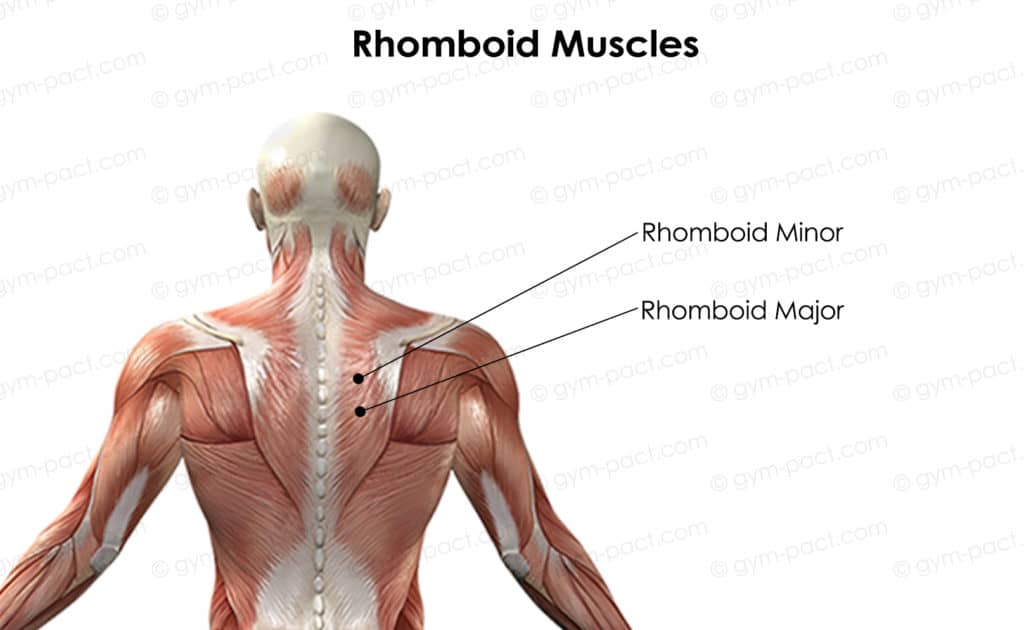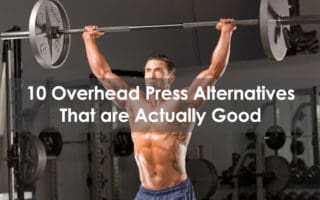The rhomboids are a set of muscles that are often ignored due to their location. However, for those trainees who are looking for a strong physique and robust posture, they need to know about these muscles. Still, these muscles are crucial for controlling the placement of the scapula and can help mitigate several types of overuse injuries from occurring. This is because while not easily seen, the rhomboids are vital for proper posture. This article will go over the best exercises you can use to isolate them for serious strengthening.
The Anatomy Of The Rhomboids
The rhomboids consist of two muscles; the rhomboid muscle which lays above the rhomboid major. As a whole, the muscles resemble a rhomboid (hence the name) which looks like an offset rectangle. The upper end of the rhomboids sit relatively high on the back; almost in the middle of the back at shoulder level. They then go down at an angle and connect to the scapula.

Why the rhomboids are easily forgotten about is because they actually sit underneath the traps. Unless you are very lean and have developed rhomboids, you will not see them. But just because you can’t see them, doesn’t mean you don’t need to train them.
Why You Need To Train Your Rhomboids
The main function of the rhomboids is to create a strong placement for the rhomboids by controlling scapula retraction and adduction. Without strong rhomboids, you won’t have efficient control over your scapula. Why is this important? Three reasons.
1) Posture:
Having strength and endurance to retract the scapula is vital for having good posture. Poor upper body posture can be caused by poor habits or because the anterior muscles (chest, anterior deltoids) are too tight and overpower the posterior muscles. This causes the shoulders to roll forward. This can only happen if the scapula protracts (moves away from the spine). Try it! Consciously retract your scapula and roll your shoulders over at the same time….you can’t! Developing your rhomboids will instantly improve your posture and overall appearance.
2) Improved Performance:
Being able to produce a solid foundation for your scapula is essential for moving big weight and getting optimal activation of your muscles. This is because your pushing AND pulling movements rely on the scapula for proper biomechanics. Have you ever heard a trainer say “protract your scapula” during an exercise? No! It’s always “Retract your scapula, try to pinch my fingers”. This is because this is the most efficient position for moving weight. Improving your scapular strength will drastically improve sports performance and resistance training performance.
3) Decrease Injury:
Similar to above, proper scapula placement is needed to maintain injury-free exercise. If not, the other muscles will have to overcompensate which results in improper biomechanics and overuse. Overuse injuries to both the shoulder AND elbow have been found to originate from deficient scapula musculature strength.
The Best Exercises To Build Strong Rhomboids
The good thing is that strengthening the rhomboids is easy. Remember, while very important, the rhomboids are fairly simple muscles. Their primary job is to retract the scapula and provide a good base.
To get a better idea of this movement, do this little exercise. Stand up tall with your shoulders straight. Now, try to squeeze your scapula together. That’s it. That’s the primary job of the scapula.
1) Band Pull Aparts
Band pull aparts may be the best exercise that trainees can add into their daily habits to strengthen their rhomboids and improve their posture. They are a fairly simplistic exercise and are often used during a warm-up to activate the rhomboids. However, if you want to make a real difference, treat them as a stand-alone exercise for rehabilitation. Even if you’re not injured, your posture is still messed up and needs to be fixed. A common practice is to knock 50-100 out every single day. This is a great exercise to do first thing in the morning to get the blood flowing.
Equipment Needed
How To Perform
- Choose a light resistance band. You should be able to do 15-20 reps in one set
- Grab the band a little closer than shoulder width apart.
- Hold your the band out with arms straight. They should be parallel to the ground
- Keeping your arms straight, pull your arms back in a sweeping motion
- Go until your arms a bit past parallel
- Come back in a controlled manner
- ALWAYS maintain some resistance. Do not allow slack
- If you need, you can stand against a wall or lay on the ground. This will prevent any hyper extension which may occur
2) Face Pulls
Face pulls are another one of the best exercises to train the rhomboids and improve scapular control. Face pulls can be used in the same context as band pull aparts; being either a great warm-up exercise or as a daily exercise to improve posture. At the same time, you can use a heavier load and train for strength and hypertrophy. This is one of the absolute best exercises that you can do to train the rhomboids
Equipment Needed
- Band and somewhere to anchor
- Or Cable machine w/ rope attachement
How To Perform
- Set up either your band OR set the cable crossover to a height of about head level
- Grab the band or rope attachment with your thumbs facing towards you
- Elevate your arms so that your elbows are at about eye level
- Pull your hands into your face (I.e. why it’s called a face pull)
- When your hands hit a distance of about 6″ in front of your face, pull them apart and up so they travel past your face
- Maintain elbow height the whole time. They should remain at or slightly above elbow height
- At the end, your hands should be above your elbows
3) Scapula Pull-Ups
Scapula pull-ups are a must for rhomboid training. Not only will they train these muscles to be stronger, but they will also train you how to engage your scapular muscles for proper placement. This will help improve your performance in every other lift you do. Remember we mentioned that strong scapular placement is vital to provide support for pulling and pushing movements. Scapula pull-ups will teach you that.
Equipment Needed
- Pull up bar
How To Perform
- Hold the bar with an overhand grip in your normal pull up position, a little wider than shoulder width apart
- If the bar is not high enough to hang freely, lift your knees to maintain your body off the floor
- Do not activate the scapula musculature. Allow your weight to sink
- Now, activate your scapula muscle and retract your scapula down. This is a very small range of motion.
- Hold for a few seconds and then repeat
4) Rear Delt Flyes (2 Versions)
Rear delt flyes are basically amped-up band pull aparts. It’s the exact same motion but they are done with a heavier load. There are two different versions of this movement that you can do..actually 3 including a machine, but we’re going to go over rear delt fly with dumbells and rear delt flys using a cable crossover machine.
Rear Delt Fly with Dumbells
Some will choose to do this exercise bent-over. However, since we are trying to really isolate the rhomboids, it’s best to use an adjustable bench to lay on in the prone position (chest on pad). This will take out any unnecessary body movement and allow the trainee to concentrate on the right muscles.
Equipment Needed
- Incline bench
- Dumbbells
How To Perform
- Set up bench so that it is at about a 60 degree angle
- Lay on the bench so that your feet are planted and chest is placed firmly in the pad
- Hold a dumbbell in each hand
- Keeping a very slight bend in your elbows, raise your arms outward
- Have your arms barely break parallel with a slight pause
- Lower smoothly
Rear Delt Flys With Cable Crossover
Using cable crossovers is another great variation. Ideally, you use both handles at the same time but if you can only use one, that’s fine. The standard cable crossover rear delt fly is done with the handles placed slightly above the shoulders. However, you can also do high-to-low and low-to-high movements as well for a little bit different stimulus
Equipment Needed
- Cable crossover machine
- Two single-handle attachments
How To Perform
- Adjust the cable crossover so that the handles are just above shoulder level
- Choose an appropriate weight (start light)
- Grab the left handle with your right hand and right handle with your left hand
- Stand back about one or two steps so that your arms are at a very slight angle
- Keeping a slight bend in your elbows, pull your arms across your body and out to the side.
- When you allow your arm to come back, be sure to at least have your arms cross slightly. This will allow a full range of motion for scapular movement and rhomboids
5) High Angle Cable Row
This movement will hit the rhomboids from both vertical and horizontal angles. It’s best to do this exercise while standing with a neutral grip attachment. You can also do the same movement unilaterally with a single handle attachment. Both are great exercises.
Equipment Needed
- Cable pulley machine
- Neutral grip attachment or single handle attachment
How To Perform
- Decide if you want to use both hand with the neutral grip attachment or single arms with the single handle attachment
- Set the cable at a high position. It should be be significantly higher than your head
- Grab the handle and step a few feet back from the pulley
- Stand with a slight bend in your knees
- Start with your arms fully extended and scapula protracted
- First, retract your scapula and then pull the your elbows back
- Concentrate on driving your elbows backward and squeezing your scapula
What Loads Should I Use For Training My Rhomboids
If you notice, the vast majority of these exercises are smaller, isolation movements. This means that you are going to use lighter loads of 80% of your 1RM or lower. This means you should be able to do at least 8 reps. However, some of the movements will allow you to do even more; upwards of 50+. This is mainly for band pull aparts and banded face-pulls (when you do them in a therapeutic manner).
Still, work these into either your back, pulling or upper body day. Since they are smaller exercises, throw them in towards the end of the workout.
Fix Your Posture NOW!
Fixing your posture is easy; you’ll just need to put in some time. Remember, one of the best things to instantly improve your appearance and aesthetics is to have a strong posture with your head up and shoulders pulled back. Training your rhomboids will do this, even if you don’t put on actual muscle mass…but don’t worry about that. With your new solid scapula placement, you’ll be able to press more weight and pull more weight which will result in serious mass and strength gains!
Frequently Asked Questions
Why Should You Do Rhomboid Strengthening Exercises?
Strengthening your rhomboids will improve both your posture and performance. This is because the rhomboids are responsible for scapula retraction and providing proper placement of the scapula. This will keep your shoulders rolled back and provide a stable base to lift from.
How to Stretch the Rhomboids?
When activated during a concentric contraction (muscle gets shorter), the rhomboids will pull the scapula medially, or towards the middle of the back. This means that if you want to stretch the, you must protract your scapula, or let them come forward. This can be done with two easy exercises:
Dead Hangs: These are performed simply by holding into a pull-up bar and allowing your body to hang. DO NOT retract your scapula though! Let them fully protract and then hang freely
Back Stretch: Find a pole and grab it with both hands. Now, pull your body away from the pole. This will cause your shoulders to come forward (scapula protraction). Now just hold this position while maintaining a slight pull.







